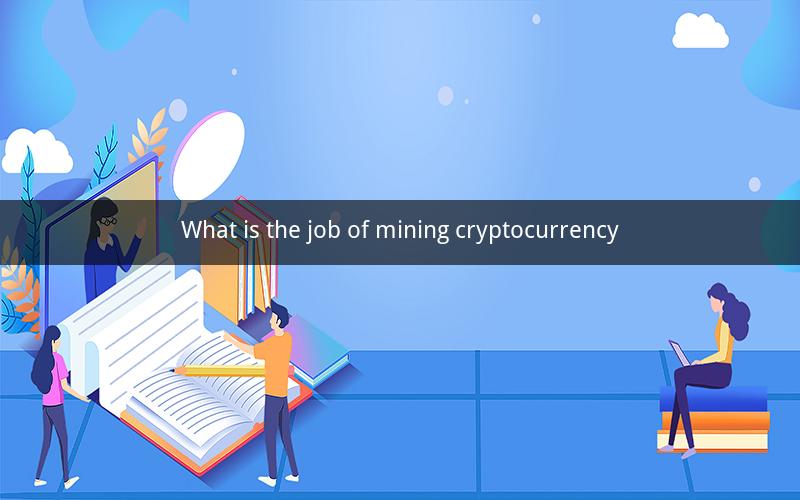
Table of Contents
1. Introduction to Cryptocurrency Mining
2. The Basics of Cryptocurrency
3. The Process of Mining
- Hardware and Software Requirements
- Mining Pools
- Proof of Work (PoW)
- The Mining Difficulty
- Energy Consumption and Sustainability
4. The Role of Mining in the Cryptocurrency Ecosystem
5. The Economic Implications of Mining
6. The Challenges and Risks of Mining
7. The Future of Cryptocurrency Mining
8. Conclusion
1. Introduction to Cryptocurrency Mining
Cryptocurrency mining is the process by which new units of cryptocurrency are entered into circulation. It is also a critical component of maintaining the ledger of transactions across the network. This process involves using computer power to solve complex mathematical problems, which are essential for the security and validation of the blockchain network.
2. The Basics of Cryptocurrency
Cryptocurrency is a digital or virtual currency that uses cryptography for security. Unlike traditional currencies, which are controlled by central authorities like banks or governments, cryptocurrencies operate independently through a decentralized network. The most famous cryptocurrency is Bitcoin, but there are thousands of other cryptocurrencies, each with its own unique characteristics and purposes.
3. The Process of Mining
3.1 Hardware and Software Requirements
To mine cryptocurrency, you need specialized hardware known as an ASIC (Application-Specific Integrated Circuit) or a GPU (Graphics Processing Unit). The hardware is designed to perform the complex calculations required for mining. Alongside the hardware, you'll need mining software that communicates with the blockchain network and the mining hardware.
3.2 Mining Pools
Mining pools are groups of miners who work together to solve the cryptographic puzzles. When a block is successfully mined, the rewards are distributed among the pool members according to their contribution. Mining pools reduce the risk of not receiving a reward and increase the chances of making a profit.
3.3 Proof of Work (PoW)
Proof of Work is a consensus mechanism used in many cryptocurrencies to prevent double-spending and to validate transactions. Miners compete to solve a cryptographic puzzle, and the first one to solve it gets to add a new block to the blockchain.
3.4 The Mining Difficulty
Mining difficulty is a measure of how hard it is to find a new block. It is adjusted over time to maintain a consistent rate of block creation. As more miners join the network, the difficulty increases, making it more challenging to mine new coins.
3.5 Energy Consumption and Sustainability
One of the most significant concerns with cryptocurrency mining is its energy consumption. The process requires a substantial amount of electricity, which has raised concerns about the environmental impact. Some miners are exploring more sustainable solutions, such as using renewable energy sources.
4. The Role of Mining in the Cryptocurrency Ecosystem
Mining serves several crucial roles within the cryptocurrency ecosystem:
- It secures the network by validating transactions and adding new blocks to the blockchain.
- It incentivizes miners to participate in the network and maintain its integrity.
- It regulates the supply of new coins, as the total supply is predetermined in many cryptocurrencies.
5. The Economic Implications of Mining
Mining has economic implications for individuals, companies, and the broader economy. Miners can earn cryptocurrency by successfully mining new blocks, and the value of these coins can fluctuate significantly. However, the costs associated with mining hardware, energy, and maintenance can be substantial.
6. The Challenges and Risks of Mining
Mining is not without its challenges and risks. The high cost of hardware, the fluctuating value of cryptocurrency, and the intense competition can make it difficult to turn a profit. Additionally, regulatory changes and technological advancements can impact the profitability and feasibility of mining operations.
7. The Future of Cryptocurrency Mining
The future of cryptocurrency mining is uncertain but likely to be influenced by several factors. These include technological advancements, regulatory changes, and shifts in the market. Some cryptocurrencies are exploring alternative consensus mechanisms that may reduce the need for mining.
8. Conclusion
Cryptocurrency mining is a complex and evolving process that plays a vital role in the cryptocurrency ecosystem. It is a testament to the power of blockchain technology and the potential of decentralized systems. As the landscape continues to change, miners must adapt to remain competitive and sustainable.
---
Questions and Answers
1. Question: What is the primary purpose of cryptocurrency mining?
Answer: The primary purpose of cryptocurrency mining is to secure the network, validate transactions, and add new blocks to the blockchain.
2. Question: How does mining create new coins?
Answer: Mining creates new coins by solving complex mathematical problems that validate transactions and add new blocks to the blockchain.
3. Question: What hardware is used for cryptocurrency mining?
Answer: ASICs and GPUs are commonly used hardware for cryptocurrency mining due to their processing power.
4. Question: What is a mining pool?
Answer: A mining pool is a group of miners who work together to increase their chances of mining a new block and sharing the rewards.
5. Question: How does the mining difficulty affect profitability?
Answer: As mining difficulty increases, the difficulty of mining a new block also increases, which can make it less profitable for miners.
6. Question: What are the environmental concerns related to cryptocurrency mining?
Answer: The environmental concern is the high energy consumption of mining, which can lead to significant carbon emissions.
7. Question: How do miners earn cryptocurrency?
Answer: Miners earn cryptocurrency by solving cryptographic puzzles and adding new blocks to the blockchain.
8. Question: Can anyone participate in cryptocurrency mining?
Answer: Anyone with the necessary hardware and software can participate in cryptocurrency mining, although the cost and technical requirements can be barriers.
9. Question: What are the risks associated with cryptocurrency mining?
Answer: Risks include high costs, fluctuating profitability, regulatory changes, and the need for advanced technical knowledge.
10. Question: How is the mining difficulty adjusted?
Answer: Mining difficulty is adjusted automatically by the network to maintain a consistent rate of block creation.